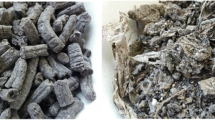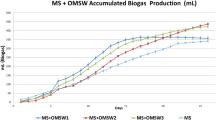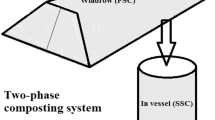Abstract
Oil refinery sludge (ORS) was mixed with shredded green wastes (GW) at ratios of 1:1 v/v (RI) and 1:3 v/v (RII). The mixtures, of approximately volumes of 1,020 l and 990 l respectively, were introduced in metal cubic containers of 1.0 m3 volume, opened at the top and with small holes punctured in the bottom and the side. The containers were additionally insulated with a layer of rockwool (20 mm). The boxes were emptied, the mixtures were turned and water was added occasionally, in one to two weeks intervals, simulating a windrow composting system. Temperature, physiochemical characteristics, mineral oil and grease (MOG) concentration, polycyclic aromatic hydrocarbons (PAHs) concentration, carbon dioxide emission, methane emission and microorganisms presence were recorded either daily or every time the mixtures were turned, for a period of 120 days. RII recorded temperatures as high as 62°C, reaching 56°C in Day 6 and retained temperatures above 50°C for more than 40 days. RI recorded its highest temperature of 53°C in Day 77. The reason why the two mixtures behaved so differently can be explained by: (i) extended co-digestion phenomena by the microorganisms decomposing the GW in RII, (ii) toxic effect of ORS in RI due to the far larger amounts used (840 kg in RI in comparison with the 460 kg in RII). After Day 36 temperature increased gradually in RI and MOG and PAHs reduction was first noted. At the end of the experiment MOG concentration in RI was 57.2 mg/kg dry weight (dw) (52.1% reduction) where in RII was 34.3 mg/kg dw (62.1% reduction). Emissions of methane and carbon dioxide support the concept of the toxic effect and the delay ignition of the decomposing process in RI. In total, CO2 and CH4 emissions from RI were recorded to be 30.8 kg and 18.5 g, respectively, where from RII 59.6 kg of CO2 and 6.4 g of CH4 were emitted. An effort was made to determine the effect of temperature alone (as an abiotic treating parameter) in both mixtures. It can be supported that about least 15% of the MOG and PAHs removal.






Similar content being viewed by others
References
Antizar-Ladislao B, Lopez-Real JM, Beck AJ (2004) Bioremediation of polycyclic aromatic hydrocarbon (PAH)-contaminated waste using composting approaches. Crit Rev Environ Sci Technol 34:249–289. doi:10.1080/10643380490434119
APHA AWWA & WEF (1995) Standard methods for the examination of water and wastewater, 19th edn. APHA Inc., Washington, DC, USA
Antizar-Ladislao B, Lopez-Real JM, Beck AJ (2005) Laboratory studies of the remediation of polycyclic aromatic hydrocarbon contaminated soil by in-vessel composting. Waste Manag 25:281–289. doi:10.1016/j.wasman.2005.01.009
Antizar-Ladislao B, Lopez-Real JM, Beck AJ (2006) Degradation of polycyclic aromatic hydrocarbons (PAHs) in an aged coal-tar contaminated soil under in-vessel composting conditions. Environ Pollut 141:459–468. doi:10.1016/j.envpol.2005.08.066
Antizar-Ladislao B, Spanova K, Beck AJ, Russell NJ (2008) Microbial community structure changes during bioremediation of PAHs in an aged coal-tar contaminated soil by in-vessel composting. Int Biodeter Biodegr Aticle 61:357–364
Atkinson CF, Jones DD, Gauthier JJ (1996) Putative anaerobic activity in aerated composts. J Ind Microbiol 16:182–188. doi:10.1007/BF01570002
Artola-Caricano E, Borkent I, Damen K, Jager T, Vaes WHJ (2003) Sorption kinetics and microbial biodegradation activity of hydrophobic chemicals in sewage sludge: model and measurements based on free concentrations. Environ Sci Technol 37:116–122. doi:10.1021/es020115y
Beaudin N, Caron RF, Legros R, Ramsay J, Lawlor L, Ramsay B (1996) Cocomposting of weathered hydrocarbon-contaminated soil. Compost Sci Util 4(2):37–45
Beaudin N, Caron RF, Legros R, Ramsay J, Ramsay B (1999) Identification of the key factors affecting composting of a weathered hydrocarbon-contaminated soil. Biodegradation 10:127–133. doi:10.1023/A:1008365832031
Bengtsson A, Quednau M, Haska G, Nilzen P, Persson A (1998) Composting of oily sludges-degradation, stabilized residues, volatiles and microbial activity. Waste Manag Res 16:273–284. doi:10.1177/0734242X9801600309
Bhatt M, Cajthaml T, Sasek V (2002) Mycoremediation of PAH-contaminated soil. Folia Microbiol (Praha) 47:255–258. doi:10.1007/BF02817647
Blanchard M, Teil MJ, Carru AM, Ollivon D, Garban B, Chesterikoff A et al (1999) PCB and PAH impacts on cytochrome P-450-dependent oxidases in roach (Rutilus rutilus) from the Seine river (France). Arch Environ Contam Toxicol 37:242–250. doi:10.1007/s002449900511
Canet R, Birnstingl JG, Malcolm DG, Lopez-Real JM, Beck AJ (2000) Biodegradation of polycyclic aromatic hydrocarbons (PAHs) by native microflora and combinations of white-rot fungi in a coal-tar contaminated soil. Bioresour Technol 76:113–117. doi:10.1016/S0960-8524(00)00093-6
FCQAO (1996) Methods book for the analysis of compost. Published by Federal Compost Quality Assurance Organization-Bundesgutegemeinschoft Kompost E.V., Abfall Now E.V. Publishing House, Stuttgart, Germany
Ferrari MD, Neirotti E, Albornoz C, Mostazo MR, Cozzo M (1996) Biotreatment of hydrocarbons from petroleum tank bottom sludges in soil slurries. Biotechnol Lett 18:1241–1246. doi:10.1007/BF00129947
Haug RT (1993) Compost engineering: principles and practice. Lewis Publishers, Boca Raton, FL
Huang GF, Wong JWC, Wuand QT, Nagar BB (2004) Effect of C/N on composting of pig manure with sawdust. Waste Manag 24:805–813. doi:10.1016/j.wasman.2004.03.011
Johnsen AR, Winding A, Karlson U, Roslev P (2002) Linking of microorganisms to phenanthrene metabolism in soil by analysis of 13C-labeled cell lipids. Appl Environ Microbiol 68:6106–6113. doi:10.1128/AEM.68.12.6106-6113.2002
Juteau P, Bisaillon JG, Lepine F, Ratheau V, Beaudet R, Villemur R (2003) Improving the biotreatment of hydrocarbons-contaminated soils by addition of activated sludge taken from the wastewater treatment facilities of an oil refinery. Biodegradation 14:31–40. doi:10.1023/A:1023555616462
Karr LA, Lysyj I (1983) Oily sludges: physical, chemical and toxicological characterization, vol 23. National Meeting—American Chemical Society, Division of Environmental Chemistry, pp 64–67
Keeling A, Griffiths B, Ritz K, Myers M (1995) Effects of compost stability on plant growth, microbiological parameters and nitrogen availability in media containing mixed garden-waste compost. Bioresour Technol 54:279–284. doi:10.1016/0960-8524(95)00138-7
Kirchmann H, Ewnetu W (1998) Biodegradation of petroleum-based oil wastes through composting. Biodegradation 9:151–156. doi:10.1023/A:1008355825404
Lasaridi K, Protopapa I, Kotsou M, Pilidis G, Manios T, Kyriacou A (2006) Quality assessment of composts in the Greek market: the need for standards and quality assurance. J Environ Manag 80:50–65. doi:10.1016/j.jenvman.2005.08.011
Lee LY, Hu JY, Ong SL, Ng WJ, Ren JH, Wong SH (2004) Two-stage SBR for treatment of oil refinery wastewater. Water Sci Technol 50(10):243–249
Leonardi V, Šašek V, Petruccioli M, D’Annibale A, Erbanovaì P, Cajthaml T (2007) Bioavailability modification and fungal biodegradation of PAHs in aged industrial soils. Int Biodeter Biodegr 60(170):165. doi:10.1016/j.ibiod.2007.02.004
Liang C, Das KC, McClendon RW (2003) The influence of temperature and moisture contents regimes on the aerobic microbial activity of a biosolids composting blend. Bioresour Technol 86:131–137. doi:10.1016/S0960-8524(02)00153-0
Madejoìn E, Jesuìs Diìaz M, Loìpez R, Cabrera F (2002) New approaches to establish optimum moisture content for compostable materials. Bioresour Technol 85:73–78. doi:10.1016/S0960-8524(02)00030-5
Manios T (2004) The composting potential of different organic solid wastes: experience from the island of Crete. Environ Int 29:1079–1089. doi:10.1016/S0160-4120(03)00119-3
Manios T, Stentiford EI (2004) Sanitary aspect of using partially treated landfill leachate as a water source in green waste composting. Waste Manag 24:107–110. doi:10.1016/S0956-053X(03)00130-2
Manios T, Maniadakis K, Boutzakis P, Naziridis Y, Lasaridi K, Markakis G et al (2007) Methane and carbon dioxide emission in a two-phase olive oil mill sludge windrow pile during composting. Waste Manag 27:1092–1098. doi:10.1016/j.wasman.2006.05.012
Marin JA, Moreno JL, Hernandez T, Garcia C (2006) Bioremediation by composting of heavy oil refinery sludge in semiarid conditions. Biodegradation 17:251–261. doi:10.1007/s10532-005-5020-2
Mata-Alvarez L, Mace S, Liabres P (2000) Anaerobic digestion of organic solid wastes: an overview of research achievements and perspectives. Bioresour Technol 74:3–16. doi:10.1016/S0960-8524(00)00023-7
Mohee R, Driver MFB, Sobratee N (2008) Transformation of spent broiler litter from exogenous matter to compost in a sub-tropical context. Bioresour Technol 99:128–136. doi:10.1016/j.biortech.2006.11.040
Olajire AA, Altenburger R, Küster E, Brack W (2005) Chemical and ecotoxicological assessment of polycyclic aromatic hydrocarbon-contaminated sediments of the Niger Delta, Southern Nigeria. Sci Total Environ 20:123–136. doi:10.1016/j.scitotenv.2004.08.014
Overcash MR, Pal D (1979) Design of land treatment systems for industrial wastes: theory and practice. Ann Arbor Science, Ann Arbor, MI, pp 152–219
Persson NA, Welander TG (1994) Biotreatment of petroleum hydrocarbons-containing sludges by landfarming. In: Hinchee RA, Alleman BC, Hoeppel RE, Miller RN (eds) Hydrocarbon bioremediation. Lewis Publishers, Boca Raton, FL, pp 335–342
Rajaguru P, Kalaiselvi K, Palanivel M, Subburam V (2000) Biodegradation of azo dyes in a sequential anaerobic–aerobic system. Appl Microbiol Biotechnol 54:268–273. doi:10.1007/s002530000322
Ryckeboer J, Mergaert J, Vaes K, Klammer S, De Clerq Q, Coosemans K et al (2003) A survey of bacteria and fungi occurring during composting and self-heating process. Ann Microbiol 53:349–410
Sasek V, Cajthaml T, Bhatt M (2003) Use of fungal technology in soil remediation: a case study. Water Air Soil Pollut 3:5–14
Stentiford EI (2001) Composting-optimising the process and keeping the neighbours happy. In: Lasaridi K, Paulopoulos K (eds) Proceeding of composting network conference, 12 June, Athens
Suler DJ, Finstein MS (1977) Effect of temperature, aeration, and moisture on CO2 formation in bench-scale, continuously thermophilic composting of solid waste. Appl Environ Microbiol 33:345–350
Tai HS, He WH (2007) A novel composting process for plant wastes in Taiwan military barracks. Res Conserv Rec 51:408–417. doi:10.1016/j.resconrec.2006.10.006
Tiquia SM, Tam NFY, Hodgkiss IJ (1996) Microbial activities during composting of spent pig-manure sawdust litter at different moisture contents. Bioresour Technol 55:201–206. doi:10.1016/0960-8524(95)00195-6
Van Gestel K, Mergaert J, Swing J, Coosemans J, Ryckeboer J (2003) Bioremediation of diesel oil-contaminated soil by composting with biowaste. Environ Pollut 125:361–368. doi:10.1016/S0269-7491(03)00109-X
Wilson SC, Jones KC (1993) Bioremediation of soil contaminated with polynuclear aromatic hydrocarbons (PAHs): a review. Environ Pollut 81:229–249. doi:10.1016/0269-7491(93)90206-4
Williams RT, Keehan KR (1992) Bioremediation using composting. In: Proceedings of National Waste Processing Conference, pp 429–433
Yang SYN, Connell DW, Hawker DW, Kayal SI (1991) Polycyclic aromatic hydrocarbons in air, soil and vegetation in the vicinity of an urban roadway. Sci Total Environ 102:229–240. doi:10.1016/0048-9697(91)90317-8
Acknowledgement
The authors would like to thank EKO Oil Company and especially K. Fotinakis for the supply of the oil refinery sludge.
Author information
Authors and Affiliations
Corresponding author
Rights and permissions
About this article
Cite this article
Fountoulakis, M.S., Terzakis, S., Georgaki, E. et al. Oil refinery sludge and green waste simulated windrow composting. Biodegradation 20, 177–189 (2009). https://doi.org/10.1007/s10532-008-9211-5
Received:
Accepted:
Published:
Issue Date:
DOI: https://doi.org/10.1007/s10532-008-9211-5




